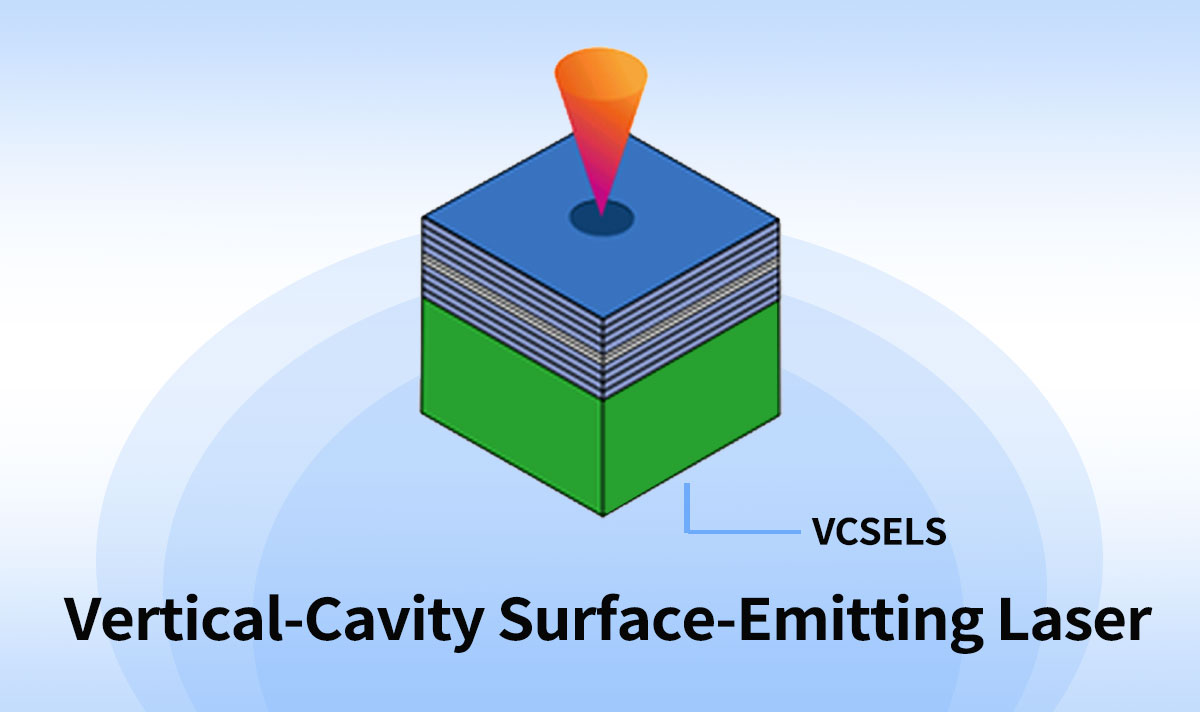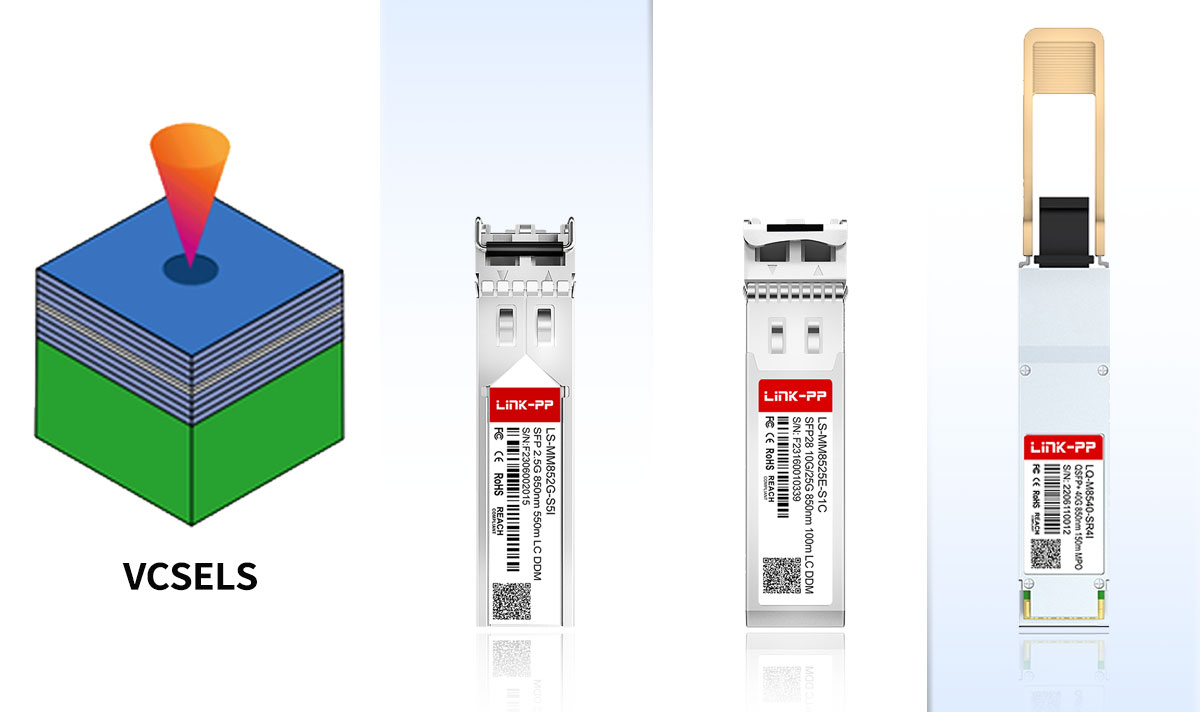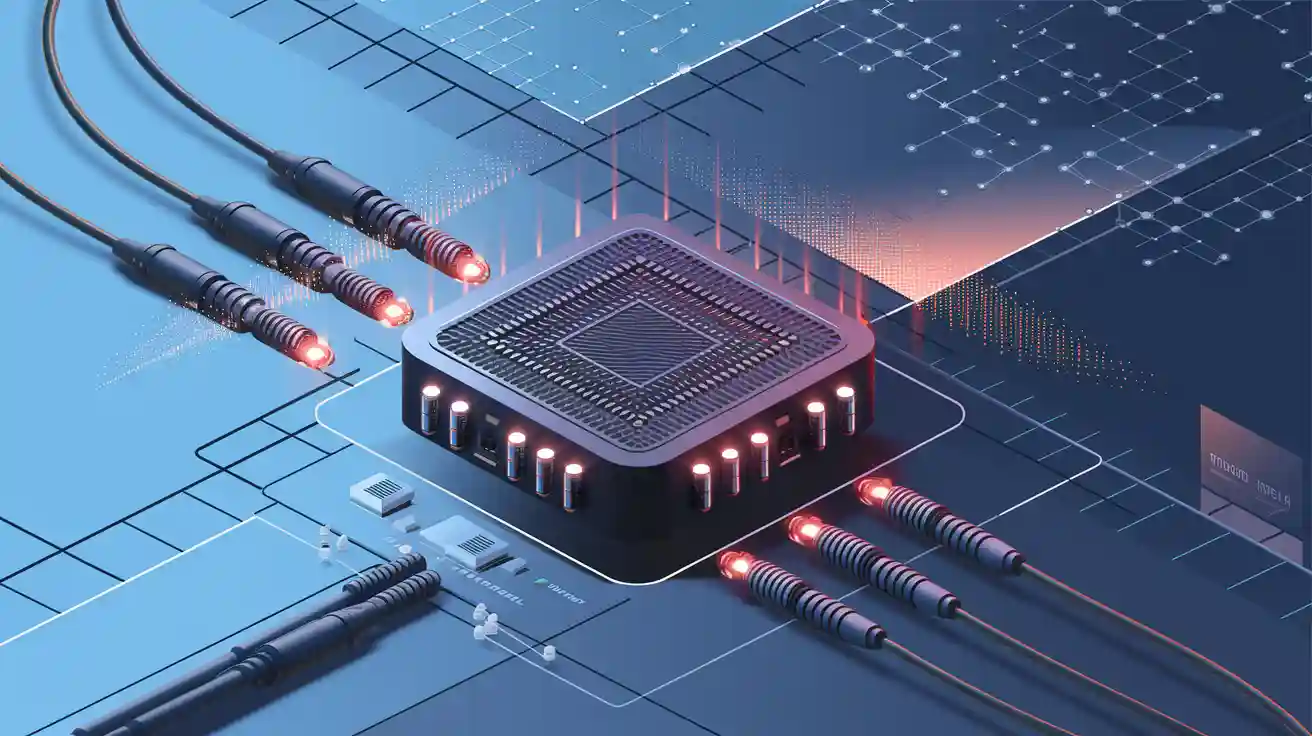
Vertical-Cavity Surface-Emitting Lasers (VCSELs) are advanced semiconductor devices that emit light vertically from the chip surface, offering a compact and efficient alternative to traditional edge-emitting lasers. Featuring a short resonant cavity formed by high-reflectivity DBR mirrors, a quantum-well active region, and current-confining oxide apertures, VCSELs deliver low threshold currents, high modulation speeds, and excellent fiber-coupling efficiency. While they excel in short-reach applications—such as data-center optical transceivers, sensing systems, and consumer 3D imaging—they are power-limited compared to edge-emitters and face challenges at longer wavelengths . Nonetheless, VCSELs’ manufacturability, scalability, and performance make them indispensable in modern optics.
🌀 What Is a VCSEL?
A Vertical-Cavity Surface-Emitting Laser (VCSEL) is a type of semiconductor laser diode that emits light perpendicular to its surface, in contrast to edge-emitting lasers that emit sideways. It consists of a very short resonant cavity sandwiched between two highly reflective Distributed Bragg Reflector (DBR) mirrors built into the wafer.
🌀How VCSEL Work
DBR Mirrors: These mirrors consist of alternating layers of different refractive index materials, reflecting over 99% of light at the lasing wavelength to form the optical cavity.
Quantum Wells Gain Medium: The active material—typically quantum wells—generates photons when electrically pumped. Light resonates between DBRs until threshold or lasing occurs.
Current & Light Confinement: Oxide apertures or proton-implanted regions confine both current and light, creating a small emission area with a circular beam pattern
🌀 Pros & Cons
Advantages of VCSELs
Wafer-Level Testing
VCSELs can be tested directly on the wafer before singulation, which reduces costs and increases manufacturing yield.Low Power Consumption
VCSELs require minimal threshold current and typically operate in the milliwatt range, offering energy-efficient performance.High Fiber-Coupling Efficiency
Thanks to their circular, low-divergence beam, they couple easily into multimode fibers with minimal loss.Modulation Speed & Scalability
VCSELs support high modulation bandwidths (>40 GHZ) and can be fabricated as 1-D or 2-D arrays—useful in modern telecom modules.Temperature Stability
The surface-emitting design enables stable wavelength behavior across temperature variations—key for reliable communication.
Limitations of VCSELs
Lower Maximum Power
VCSELs typically offer fewer milliwatts of output compared to edge-emitting lasers, limiting their use in long-haul applications.Long-Wavelength Limitations
Mass production of high-power VCSELs at telecom wavelengths (1,300–1,550 nm) remains challenging.Array Uniformity Challenges
Variations in array performance can impact overall link quality, particularly in multi-channel modules.
🌀 Common Applications
Data Communications: Backbone of optical transceivers (SFP, QSFP, SFP28) used in data centers and enterprise networks.
Consumer Electronics: Used in facial recognition, proximity sensors, and 3D imaging for smartphones and laptops.
Automotive LiDAR & Sensing: Powers compact, high-resolution vision systems for autonomous vehicles.
Industrial & Biomedical Devices: Utilized in printers, optical mice, medical diagnostics, and environmental monitoring.
Why VCSELs Matter in Optical Modules
VCSEL technology underpins the performance of many LINK‑PP optical transceivers:
Energy-efficient & compact: VCSELs require milliwatts per lane and occupy minimal PCB space, reducing heat and simplifying thermal design.
High-speed readiness: Modern oxide-confined VCSELs support data rates up to 25–50 Gbps per lane using advanced modulation (e.g., PAM‑4).
Scalable arrays: LINK‑PP’s 4-channel VCSEL arrays facilitate.

VCSEL in LINK‑PP Transceivers
Here are four key LINK‑PP modules powered by VCSEL technology:
LS‑MM8532‑S1C 32G SFP28
Incorporates an 850 nm VCSEL transmitter, PIN photodiode, TIA amplifier, and MCU—ideal for reliable 32 Gbps 100m-reach with DDMI.LS‑MM852G‑S5I 2.5G SFP
Uses a VCSEL laser for 2.5 Gbps over multimode fiber up to 550 m—great for legacy systems and Industrial use.LS‑MM8525E‑S1C 25G SFP28
Features a high-speed 850 nm VCSEL transmitter with PIN receiver—supporting 25 Gbps links for emerging data-center needs.LQ‑M8540‑SR4I 40G QSFP+
Integrates a four-channel 850 nm VCSEL array to achieve 4×10 Gbps in high-density multimode environments.
🌀 VCSEL vs. DFB Laser
Feature | VCSEL | |
|---|---|---|
Emission Direction | Surface (vertical) | Edge, longer cavity |
Wavelength Stability | Moderate, suitable for multimode fiber systems | Excellent, narrow‐linewidth ideal for DWDM & long‑haul telecom |
Mode Output | Can be single/multi‐mode based on design | Typically single‑mode via Bragg grating |
Fiber Compatibility | Highly efficient coupling to multimode fibers | Designed for single‑mode fiber transmission |
Modulation Bandwidth | Supports tens of GHz (10–50 Gbps) | Typically supports 10–15 Gbps, with coherent modulation available |
Testing & Cost | Wafer-level testing, high yield and cost efficiency | Higher cost due to fabrication precision and narrow-linewidth performance |
Use Cases | Short-reach data center links (SFP+/SFP28), sensing, LiDAR | Long-haul DWDM telecom, sensing, precise measurement |
🌀FAQ
What does VCSEL stand for?
VCSEL stands for Vertical-Cavity Surface-Emitting Laser. This type of laser emits light vertically from the surface of a semiconductor chip, not from the edge.
How do VCSELs differ from traditional lasers?
VCSELs emit light perpendicular to the chip surface. Traditional lasers, like edge-emitters, send light out from the side. VCSELs allow easier testing, better integration, and often use less power.
Where can people find VCSELs in everyday life?
People use VCSELs in smartphones for facial recognition, in computer mice, and in data centers for fast internet connections. Many cars use VCSELs in LiDAR systems for safety features.
Are VCSELs safe for human eyes?
Most VCSELs operate at low power and use wavelengths that reduce eye risk. Manufacturers design devices to meet strict safety standards. Users should still avoid staring directly into any laser source.
What are the main advantages of VCSELs?
VCSELs offer high speed, low power use, and easy integration into arrays. They provide stable performance and support many applications, from data communication to medical imaging.
See Also
An Introduction To Distributed Feedback Lasers Explained
Exploring Erbium-Doped Fiber Amplifiers And Their Optical Uses
Understanding Wavelength Division Multiplexing And Its Optical Applications


